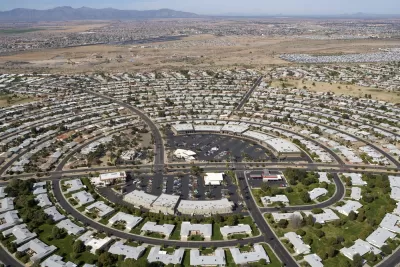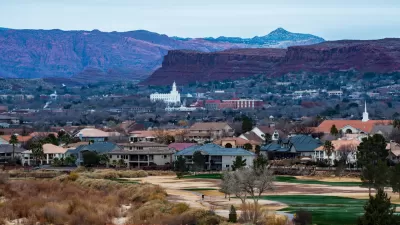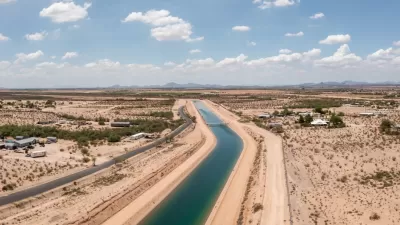New communities are popping up across Arizona’s desert, evading water consumption restrictions and straining the state’s groundwater supplies.

Reporting for KJZZ, Katherine Davis-Young examines Arizona’s increasingly urgent water crisis. As Davis-Young explains, “Maricopa County’s population has more than doubled over the past 30 years, making it one of the fastest growing regions in the country. But meanwhile, Arizona’s water supply has become more and more depleted.”
The 1980 Groundwater Management Act called on the state to use underground aquifers primarily as a back-up and employ tactics to replenish groundwater supplies, but Kathleen Ferris, a researcher from Arizona State University, says that has not been happening.
“In most areas of central Arizona, a developer can’t build a new home without first proving that there’s enough water to last that property 100 years. But there are loopholes for larger lots in rural areas, like many homes in Rio Verde Foothills.” And while some cities like Phoenix have actually reduced their water use even as their population grew, rapid development happening in undeveloped desert areas largely counts on groundwater. “Back in 1980, legislators set a target to achieve safe yield of groundwater by 2025. So Ferris thinks the time for elected leaders to start answering questions about growth and sustainability is now.”
More Planetizen coverage of the water crisis in the American West:
FULL STORY: Arizona's water supply is shrinking, but its population is growing. Is it sustainable?

Study: Maui’s Plan to Convert Vacation Rentals to Long-Term Housing Could Cause Nearly $1 Billion Economic Loss
The plan would reduce visitor accommodation by 25,% resulting in 1,900 jobs lost.

Alabama: Trump Terminates Settlements for Black Communities Harmed By Raw Sewage
Trump deemed the landmark civil rights agreement “illegal DEI and environmental justice policy.”

Why Should We Subsidize Public Transportation?
Many public transit agencies face financial stress due to rising costs, declining fare revenue, and declining subsidies. Transit advocates must provide a strong business case for increasing public transit funding.

Paris Bike Boom Leads to Steep Drop in Air Pollution
The French city’s air quality has improved dramatically in the past 20 years, coinciding with a growth in cycling.

Why Housing Costs More to Build in California Than in Texas
Hard costs like labor and materials combined with ‘soft’ costs such as permitting make building in the San Francisco Bay Area almost three times as costly as in Texas cities.

San Diego County Sees a Rise in Urban Coyotes
San Diego County experiences a rise in urban coyotes, as sightings become prevalent throughout its urban neighbourhoods and surrounding areas.
Urban Design for Planners 1: Software Tools
This six-course series explores essential urban design concepts using open source software and equips planners with the tools they need to participate fully in the urban design process.
Planning for Universal Design
Learn the tools for implementing Universal Design in planning regulations.
Smith Gee Studio
Alamo Area Metropolitan Planning Organization
City of Santa Clarita
Institute for Housing and Urban Development Studies (IHS)
City of Grandview
Harvard GSD Executive Education
Toledo-Lucas County Plan Commissions
Salt Lake City
NYU Wagner Graduate School of Public Service





























